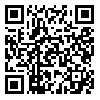BibTeX | RIS | EndNote | Medlars | ProCite | Reference Manager | RefWorks
Send citation to:
URL: http://jdisabilstud.org/article-1-3125-fa.html


 ، سعید وزیری*2
، سعید وزیری*2 
 ، محمدحسین فلاح3
، محمدحسین فلاح3 
 ، نجمه سدرپوشان4
، نجمه سدرپوشان4 

2- استادیار گروه روانشناسی و علوم تربیتی، دانشکده علوم انسانی، واحد یزد، دانشگاه آزاد اسلامی، یزد، ایران
3- دانشیار گروه روانشناسی و علوم تربیتی، دانشکده علوم انسانی، واحد یزد، دانشگاه آزاد اسلامی، یزد، ایران
4- استادیار گروه مشاوره، واحد خمینیشهر، دانشگاه آزاد اسلامی، خمینیشهر، ایران
چکیده
زمینه و هدف: گستردگی جوانب ارزیابیشده، فقدان ملاکهای شفاف و بیتوجهی به آنها زمینه را برای نارضایتی و طلاق در زوجین فراهم میآورد. این پژوهش با هدف دستیابی به مؤلفههای مهم در انتخاب همسر بهعنوان عوامل محافظ از نارضایتی و گرایش به طلاق در فرهنگ ایرانی از دیدگاه متخصصان حوزهٔ خانواده انجام گرفت.
روشبررسی: پژوهش حاضر بهصورت ترکیبی بود که بخش کیفی آن با شیوهٔ پدیدارشناسی اجرا شد. در این پژوهش دو گروه نمونه شامل گروه روانشناسان و مشاوران خانواده و گروه پانل مشتمل بر اساتید دانشگاه و دانشجویان رشتهٔ روانشناسی و مشاوره در مقطع کارشناسیارشد، شرکت داشتند. در مرحلهٔ کیفی پس از انجام مصاحبهٔ نیمهساختاریافته با گروه اول، تحلیل دادهها با روش کلایزی (۱۹۷۸) صورت گرفت و در مرحلهٔ کمّی، اعتبار دادهها براساس نظرات گروه پانل با تعیین روایی محتوایی آنها سنجیده شد. اعتباریابی دادهها باتوجه به چهار ملاک قابلیت اعتماد گوبا و لینکلن (۱۹۸۹) شامل قابلیتهای اعتبار، ثبات، تأیید و انتقال انجام گرفت. بهمنظور تعیین ضرورت وجود هریک از طبقهها برای درونمایههای مدنظر، شاخص نسبت روایی محتوا براساس نظرات گروه پانل محاسبه شد. در مرحلهٔ بعد با مراجعه به جدول لاوشه برای ده مشارکتکننده با ضریب ۰٫۶ بهعنوان نقطهٔ بحرانی و ضرورت طبقه، اعتباریابی صورت گرفت.
یافتهها: با تحلیل مصاحبهها، کدهای باز و مضمونها استخراج شد که شامل ۳۹۷ کد توصیفی و ۵۲ مضمون فرعی و ۷ مضمون اصلی بود. تمام طبقات اصلی روایی پذیرفتنی را بهدست آوردند.
نتیجهگیری: ویژگیهای شخصیتی، سابقهٔ رشدی خانوادگی، بیان عشق و احساسات، معنویت و انتظارات دینی، مدیریت امور مالی و اقتصادی، تعارض و حل آن و خانوادهها و آداب و رسوم، بهعنوان مؤلفههای اصلی انتخاب همسر بهدست آمدند که میتوانند در رضایت زناشویی زوجین و پیشگیری از طلاق کارآمد باشند.
| بازنشر اطلاعات | |
 |
این مقاله تحت شرایط Creative Commons Attribution-NonCommercial 4.0 International License قابل بازنشر است. |


